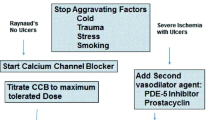Abstract
Digital ischemia is commonly found in patients with scleroderma and has been shown to respond to peripheral digital sympathectomy. While favorable long- and intermediate-term results have been documented in the literature, minimal objective data are available and the mechanism of surgical sympathectomy has not been entirely elucidated. Patients with digital ischemia secondary to Raynaud’s phenomenon that had undergone peripheral sympathectomy surgery between 2001 and 2009 were identified and contacted for participation. Radial artery Doppler ultrasound studies were performed and compared to those done at the time of their sympathectomy. Of 11 patients treated over a 9-year period, only two patients were available for detailed follow-up analysis. Four patients were deceased, and two were lost to follow-up. Four of the five remaining patients reported excellent use of the hand and no significant episodes of digital ischemia. Of the two patients studied, functional results were favorable and pain was markedly improved despite worsening of the digital flow resistance over time. We conclude that peripheral digital sympathectomy may provide favorable long-term results in patients with digital ischemia from autoimmune causes, although this intervention should be considered in the early stages once ischemic symptoms manifest. Interestingly, Doppler data did not appear to correlate with functional status and symptom severity in these two patients. Further research, particularly prospective studies, is warranted to guide clinical decisions in this patient population.




Similar content being viewed by others
References
Greengrass RA, Feinglass NG, Murray PM, Trigg SD (2003) Continuous regional anesthesia before surgical peripheral sympathectomy in a patient with severe digital necrosis associated with Raynaud’s phenomenon and scleroderma. Reg Anesth Pain Med 28:354–358
Tomaino MM, Goitz RJ, Medsger TA (2001) Surgery for ischemic pain and Raynaud’s phenomenon in scleroderma: a description of treatment protocol and evaluation of results. Microsurgery 21:75–79
Miller NE (1969) Learning of visceral and glandular responses. Science 163:434–445
Jobe JB, Sampson JB, Roberts DE, Beetham WP Jr (1982) Induced vasodilation as treatment for Raynaud’s disease. Ann Intern Med 97:706–709
Zhong J (1993) Clinical applications of acupoint Renying (St 9). J Tradit Chin Med 13:205–206
Kaada B (1982) Vasodilation induced by transcutaneous nerve stimulation in peripheral ischemia (Raynaud’s phenomenon and diabetic polyneuropathy). Eur Heart J 3:303–314
Francaviglia N, Silvestro C, Maiello M, Bragazzi R, Bernucci C (1994) Spinal cord stimulation for the treatment of progressive systemic sclerosis and Raynaud’s syndrome. Br J Neurosurg 8:567–571
Belch JJ, Ho M (1996) Pharmacotherapy of Raynaud’s phenomenon. Drugs 52:682–695
Thompson AE, Shea B, Welch V, Fenlon D, Pope JE (2001) Calcium-channel blockers for Raynaud’s phenomenon in systemic sclerosis. Arthritis Rheum 44:1841–1847
Berger A, Tizian C, Zenz M (1985) Continuous plexus blockade for improved circulation in microvascular surgery. Ann Plast Surg 14:16–19
Flatt AE (1980) Digital artery sympathectomy. J Hand Surg Am 5:550–556
Morgan RF, Reisman NR, Wilgis EF (1983) Anatomic localization of sympathetic nerves in the hand. J Hand Surg 8:283–288
Koman LA, Smith BP, Pollock FE Jr, Smith TL, Pollock D, Russell GB (1995) The microcirculatory effects of peripheral sympathectomy. J Hand Surg 20:709–717
Morgan RF, Wilgis EF (1986) Thermal changes in a rabbit ear model after sympathectomy. J Hand Surg 11:120–124
McCall TE, Petersen DP, Wong LB (1999) The use of digital artery sympathectomy as a salvage procedure for severe ischemia of Raynaud’s disease and phenomenon. J Hand Surg 24:173–177
Merritt WH (1997) Comprehensive management of Raynaud’s syndrome. Clin Plast Surg 24:133–159
Ruch DS, Holden M, Smith BP, Smith TL, Koman LA (2002) Periarterial sympathectomy in scleroderma patients: intermediate-term follow-up. J Hand Surg 27:258–264
Murata K, Omokawa S, Kobata Y, Tanaka Y, Yajima H, Tamai S (2012) Long-term follow-up of periarterial sympathectomy for chronic digital ischaemia. J Hand Surg Eur 37:788–793. doi:10.1177/1753193412441757
Kotsis SV, Chung KC (2003) A systematic review of the outcomes of digital sympathectomy for treatment of chronic digital ischemia. J Rheumatol 30:1788–1792
Momeni A, Sorice SC, Valenzuela A, Fiorentino DF, Chung L, Chang J (2015) Surgical treatment of systemic sclerosis-is it justified to offer peripheral sympathectomy earlier in the disease process? Microsurgery. doi:10.1002/micr.22379
Hartzell TL, Makhni EC, Sampson C (2009) Long-term results of periarterial sympathectomy. J Hand Surg Am 34:1454–1460. doi:10.1016/j.jhsa.2009.05.003
Bogoch ER, Gross DK (2005) Surgery on the hand in patients with systemic sclerosis: outcomes and considerations. J Rheumatol 32:642–648
Wilgis EF (1985) Digital sympathectomy for vascular insufficiency. Hand Clin 1:361–367
Acknowledgments
We would like to thank the Ochsner Clinic Foundation Publishing Services team as well as Dr. Lauren D. Vazquez for proofreading this submission.
Author’s contribution
José R. Soberón Jr. helped design the study, conduct the study, analyze the data, and write the manuscript. Roy A. Greengrass helped conduct the study, analyze the data, and write the manuscript. William E. Davis helped analyze the data and write the manuscript. Peter M. Murray helped conduct the study and write the manuscript. Neil Feinglass helped analyze the data and write the manuscript.
Author information
Authors and Affiliations
Corresponding author
Ethics declarations
Conflict of interest
José R. Soberón, Jr. received research funding from Pacira Pharmaceuticals (Parsippany, NJ). His institution received an unrestricted research grant from Pacira Pharmaceuticals in 2013. This grant was not used to fund this study, and Pacira Pharmaceuticals’ goods and services are not discussed in this manuscript. Roy A. Greengrass, William E. Davis, Peter M. Murray, and Neil Feinglass have reported no conflicts of interest.
Rights and permissions
About this article
Cite this article
Soberón, J.R., Greengrass, R.A., Davis, W.E. et al. Intermediate-term follow-up of chronically ill patients with digital ischemia treated with peripheral digital sympathectomy. Rheumatol Int 36, 301–307 (2016). https://doi.org/10.1007/s00296-015-3383-1
Received:
Accepted:
Published:
Issue Date:
DOI: https://doi.org/10.1007/s00296-015-3383-1




